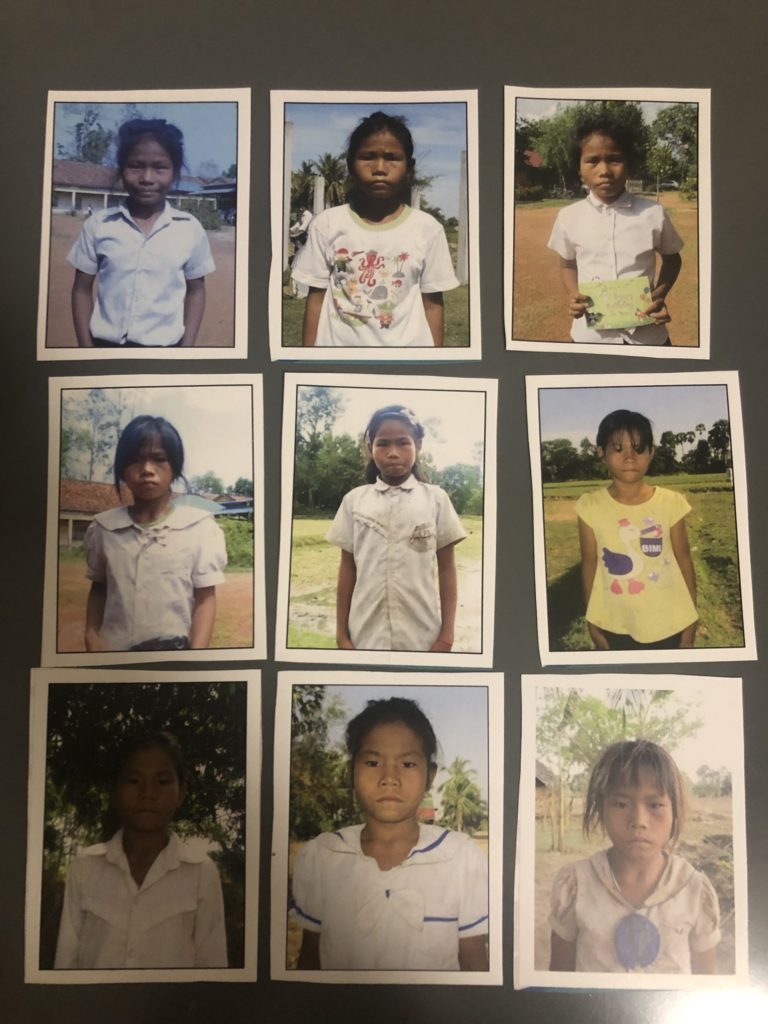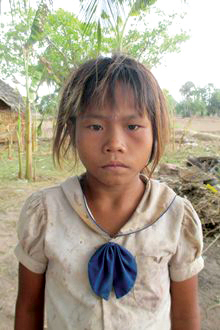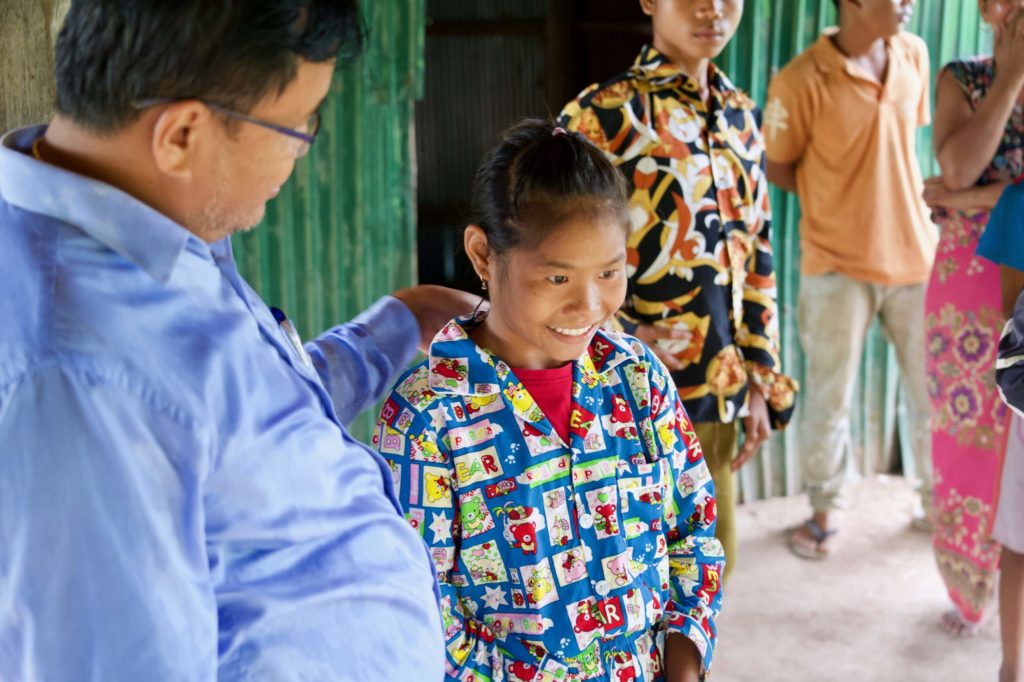In the summer of 2016, Holt sponsor and then Holt employee Billie Loewen met a very sad, hungry girl in a remote village in Cambodia. She immediately signed up to sponsor her. Four years later, she receives an update that makes her heart soar.
In the first week of every month, I pull open the Excel spreadsheet with four years of monthly budgets. I open the Chase app and Wells Fargo and drift quickly over the charges, looking for anything amiss. The single line with a shortened title, “HOLT INTL CHILD,” and associated charge — $38 — always catches my eye.
Most months, paying bills is the only time I think about what it costs to sponsor the beautiful, shy, heartbreakingly sad little girl I met in a village in Cambodia on a scorching hot, dusty day in 2016.
Tiny, impossibly thin with straggly hair turning yellow from lack of nutrition, and a broad face with deep, serious eyes, 10-year-old Phal captured my entire heart the moment I saw her.
It’s been four years since I met her, and I think about her a lot.

Her picture is on my fridge, clipped with a heavy magnet and stacked in chronological order with all the other pictures of her that I’ve cut from sponsored child reports over nearly four years. When I stand at the fridge, peering over the shelves mindlessly over the smattering of deli meat and single-serve puddings, her picture often catches my eye and I wonder if she has enough to eat, if she’s doing better in school, if kids are being nice to her, if her siblings (her legal guardians) are okay, and what they do for work.
I worry about her. Most of the time when I think about her, I close my eyes and say a silent little prayer. Please stay in school, baby girl. Just keep fighting.
But when I’m paying bills, that’s the only time I think about what I’m investing in her — and admittedly, and with a fair amount of embarrassment, there are times when, not unlike that streaming service subscription I never use, I’ve thought about cancelling.
I could save that $38 each month. The little things — they add up!
But then I remember the way she avoided my gaze as she sat among a small group of children all dressed in the same black pants or skirts and white button-down shirts — how she burst into quiet streaming tears and hid her face when I sat next to her in the shade of a small hut, on a platform made of string-tied branches and poles.

“Why’s she crying?” I asked our translator, confused.
He wrinkled his kind face in her direction and stood to come closer, pulling his pants up as he hunched and moved from one end of the platform to another in two quick steps. Twenty or so little pairs of eyes followed him, landing squarely on Phal.
They exchanged a few words in Khmer. Phal kept her face low and her voice barely audible. Eventually, the translator pulled his face back and looked at me, staring expectantly. He paused and walked over to the owner of the hut — a village leader and elderly man with a thin frame and a slight hunch in his shoulders. The man came over and grabbed her by the hand, whisking her away.
“She’s hungry,” the translator finally said to me. “She hasn’t eaten in a few days. We will get her a meal.”
Let me step back for a second and explain what on earth led me to that moment — to a small, crying child in the middle of a dry, sprawling rice paddy in the virtual middle of nowhere, deep in a quiet, rural village with huts dotting the otherwise flat, brown landscape.

For five years, from 2013-2018, I had the distinct pleasure of working at Holt International — leading marketing initiatives from their Eugene, Oregon headquarters. As part of that role, I had the opportunity to travel, seeing where and how donor money was being invested in the lives of children, in families, in entire communities — and creating incredible change.
I was lucky enough to tell lots of children’s stories. I wrote about kids waiting for families, single moms doing everything in their power to keep their families healthy and together, and the powerful teachers, social workers and community development professionals devoting their lives and careers to children in need.
I traveled to India, China, the Philippines, Vietnam and, most memorable for so many reasons, Cambodia.
Cambodia is where I met Phal — on an otherwise normal visit to a normal village where I expected to meet mostly happy kids and mostly happy families, albeit, those with very hard needs. But Phal was different.

Phal was clearly hungry. She wore a dirty school uniform and barely attended class because she was so often held home to help with chores. Her home life was gut wrenching. Her father died in an accident, and grief and despair took her mother, her farm and ultimately, her home. She moved in with an aunt, where she was just one more mouth to feed. She was in a desperate place.
I became her sponsor that same day. I logged onto Holt’s website and clicked through photos of children waiting for sponsors until I found her. I returned to the U.S. with her still heavy on my heart.
I’m a fairly demanding, tenacious, persuasive person and I’ve got grit to outlast most people, so I immediately started asking what more I could do for her. Could I pay for extra food? Could we do something extra for her family?
One day, I received a tough update on her situation. It was clear her home life wasn’t improving. So I helped craft our year-end fundraiser around Phal and kids just like her — kids in Holt’s programs with the most extreme and life-threatening needs. The funds raised could help do a little something above and beyond the normal assistance children and families receive every month from their sponsors. It could buy things like homes and major surgeries and pay off predatory debts and do that little bit of extra that saves even the most vulnerable of lives.

Thanks to donors, Phal’s community received the resources to build a house for her and her older siblings. She reunited with her twin brother. And while life was not easy, she was back in a loving family who — while hungry, while living in one of the most impoverished places on earth, while fighting food shortages and drought and trafficking risks and zero job opportunities — wanted the best for Phal, and protected her.
Slowly, years went by. Each month, $38 moved from my bank account to Holt.
The quarterly updates on Phal were okay, but not great. She looked cleaner. Her hair was no longer tinted orange from malnutrition. She was gaining weight. But she still struggled to catch up in school and I worried she would drop out.

She never smiled.
I said a sad farewell to my role at Holt to attend business school and work as a tech consultant. But I stayed in touch with my former team from Holt.
A friend from Holt visited Phal’s village and sent me a picture of her holding all the cards and photos I’d sent her over the years. She was not smiling, but it warmed my heart to know that she remembered me.

Her house was nice, I heard. Her siblings were working so hard to make ends meet. But, yes, Phal was still a very shy kid — not just quiet and modest the way most kids in Cambodia tend to be, but uniquely sad.
She was a little girl living with the complexity of adult heartbreak.
More years passed. More quiet hoping that Phal would just please, please, please stay in school. It may not seem like it, but in a place like Phal’s village, the difference between a third-grade education and a sixth-grade education is massive. Every minute spent in school gives a girl in the developing world more protection from exploitation, from early marriage, from having babies before they are fully grown, from a life with very few freedoms.
Then, out of the blue one day in September 2019, I got a text message from my old Holt crew. I knew they were in Cambodia and I asked, if they just happened to go to the very remote, very far-out-of-the-way, very tricky-to-reach village where Phal lived, to say hi to her. But I didn’t expect the update I received.

“Billie, we saw Phal yesterday!! She looked SO good and smiled a lot. We showed her a picture of you and she said she remembered you. Her house is one of the nicest in the village and she lives there with her older brother. She told us she’s happier than she was three years ago.”
My heart soared, and I scrolled to see three of the most beautiful images I’ve ever seen. Phal, looking much bigger and older than I expected, in bright jammies, with a giant smile spread beautifully across her face. She looked healthy and vibrant. Her eyes were shining. She looked so good.
I cried with joy for the sad little girl I’d spent years worrying about. She wasn’t a sad little girl. She was a teenager — beautiful, healthy, working hard in school, surrounded by the love of family.

A few days later, I got more pictures, from a Holt coworker who paid to purchase Phal and her twin brother new bikes! (Theirs were basically falling apart and the cost to replace them was very out of reach for her still struggling family). I had never seen Phal’s brother, and the images made my heart soar again.
To see how many people rallied around this child, this family, this community — and, in turn, how they also rallied around one another and maximized every bit of assistance, training and help they received — was powerful.
Child sponsorship doesn’t work over night. While miracles exist, breaking the chains of poverty is a generational game. That’s why sponsorship — why the $34 or $38 or however much you give every month — is truly an investment. The longer sponsors give, the longer children and families do the very hard work required to stay in the program, and the greater the return.
It’s easy to wonder if your very generous, very hard-earned dollars are doing everything they’re supposed to. Are they really feeding a hungry tummy? Are they keeping a child in the classroom? Are they keeping them safe? Are they warm and healthy?

The reality is that every single child in Holt’s programs has complex, intense needs. They wouldn’t be in the program if they weren’t facing poverty and at least one additional thing — like living in a single-parent family, living as a migrant, living in a dangerous location, living with a parent with disabilities, living in a place still dealing with a violent history or living in an orphanage. They are, without a doubt, at risk of losing their home, their family, their opportunity at an education. Those are all luxuries in the communities where Holt works.
Because of these complex, multi-layered set of needs, some families don’t stay in the program. They move unexpectedly, usually in search of work. They pull their daughters from school because they need the income and don’t see any point in delaying the inevitable.

But for thousands of children and families, child sponsorship can and does work, and yes, every single dollar slowly but surely makes an incredible difference. I’ve seen it with my own eyes in the communities and orphanages I’ve been lucky to visit as a Holt employee. I’ve also seen it as a Holt sponsor as I pour over the words describing my sponsored child’s progress in regular child reports.
For Phal, it’s working. I still hope every day that she keeps fighting — to stay in school, to reclaim her happiness, to grow strong and maybe just a little bit demanding and tenacious in pursuit of her dreams.
If Phal’s willing to keep fighting, I’m not about to give up on her.
And if and when, someday, she graduates the program, there will always be another child who needs a generous heart to promise to fight for them.
Billie Loewen | Child Sponsor

Become a Child Sponsor
Connect with a child. Provide for their needs. Share your heart for $43 per month.





Billie you are missed here. It is no surprise to see this story here – it is an amazing account that really shows the value of sponsoring for the giver and the receiver. Tears as I read this. Thank you for showing how to be a tremendous advocate for children and for sharing this.